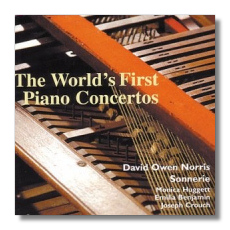
The Internet's Premier Classical Music Source
Related Links
-
Abel Reviews
J.C. Bach Reviews - Latest Reviews
- More Reviews
-
By Composer
-
Collections
DVD & Blu-ray
Books
Concert Reviews
Articles/Interviews
Software
Audio
Search Amazon
Recommended Links
Site News
 CD Review
CD Review
The World's First Piano Concertos

- Johann Christian Bach:
- Piano Concerto in E Flat Major, Op. 7 #5
- Piano Concerto in G Major, Op. 7 #6
- Piano Concerto in D Major, K. 107 (arr. Mozart)
- Carl Friedrich Abel: Piano Concerto, Op. 11 #2
- Philip Hayes: Concerto in A Major
- James Hook: Concerto in D Major, Op. 1 #5
David Owen Norris, piano
Sonnerie
Avie AV0014 DDD 79:57
This intriguing disc of "The World's First Piano Concertos" offers good, lightweight listening and unusual sonorities. Composed in 1769, the Concerto in a by Philip Hayes (so overweight, apparently, that his nickname was "Fill Chaise"!), is assigned the honor, rightly or wrongly, of being the very first work in this genre. The place was London, and the piano in question was the tiny square piano manufactured by Zumpe and Buntebart. This instrument's sound was so small that it would easily have been overwhelmed by a full-size orchestra, so it was accompanied by a similarly small ensemble, such as a trio of two violins and a cello. What makes these works piano concertos and not piano quartets, then? The answer lies in the style of the writing: the piano clearly plays a solo role, entering into dialogues, competitions, and question-and-answer sessions with the string players. Of course it was up to Mozart to bring the genre into its early maturity.
Johann Christian Bach was, of course, Johann Sebastian Bach's youngest son. He became known as "The London Bach," as he spent the last twenty years of his life in that city, serving as Music Master for the Queen, who, it should be remembered, was a native German-speaker herself. The two Op. 7 concertos presented are here the most demanding and rewarding of a set of six. (Many musical works were published in sets of six during the 1700s.) The D-Major concerto is actually Mozart's arrangement of Johann Christian's Piano Sonata Op. 5, #3. Mozart valued Johann Christian's music, and converted three of his mentor's sonatas into piano concertos during a visit to London in 1772. (That is why this concerto has a Köchel number.) Carl Friedrich Abel was another German who made his career in London. Philip Hayes and James Hook were native Englishmen. As suggested above, the music is neither profound nor especially distinctive, but it is fun to listen to, especially given the banjo-like (!) sonority of the square piano.
David Owen Norris plays a Zumpe and Buntebart square piano from 1769. (In the Bach/Mozart concerto, he plays Zumpe instrument from 1777-78, as it is likely that Mozart played on one. In fact, he may even have written his famous Piano Sonata in a minor on such an instrument.) The other musicians are violinists Monica Huggett and Emilia Benjamin and cellist Joseph Crouch. All play instruments from the 1700s, or reproductions thereof. The booklet notes are informative, and the engineering captures the sparkle and intimacy of the music.
Copyright © 2003, Raymond Tuttle




















